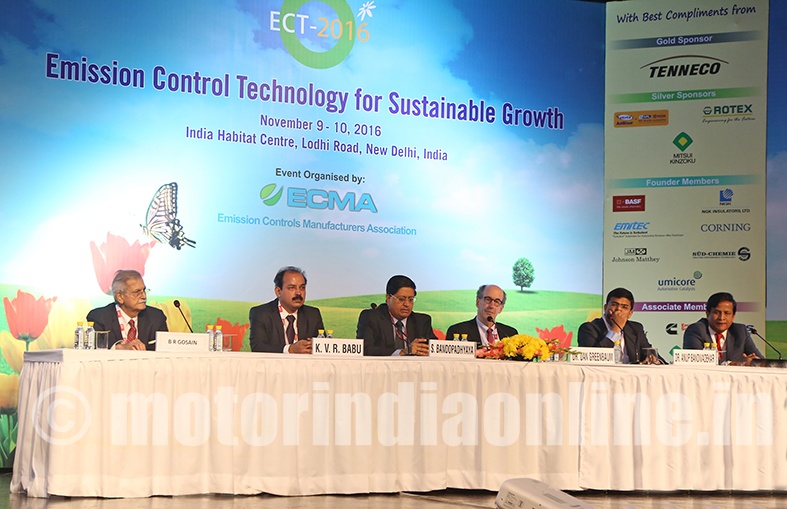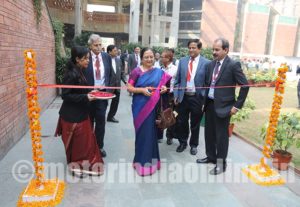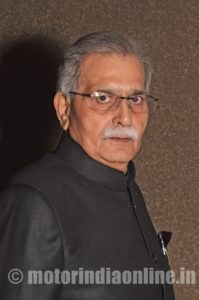The Emission Controls Manufacturers Association (ECMA), MECA’s international affiliate association in India, organized its ninth international Emission Control Technology (ECT) conference in New Delhi on November 9-10. Themed ‘Emission Control Technology for Sustainable Growth’, the conference highlighted the latest air quality issues in the country and discussed emission control technologies that will enable vehicle and engine manufacturers to achieve future standards. The two-day conclave, which was attended by renowned speakers, analysts, policymakers, panelists and delegates worldwide, also dealt on a wide range of issues and strategies on technology leapfrog from BS-IV to BS-VI norms by 2020.

While Tenneco Automotive India Pvt. Ltd. was this event’s Gold Sponsor, Rotex Automation Ltd., NPL Bluesky Automotive Pvt. Ltd. and Mitsui Kinzoku Components India Pvt. Ltd. were the Silver Sponsors. Apart from the four key sponsors displaying their products and solutions, companies like Continental Automotive Components (India) Pvt. Ltd., Süd-Chemie India Pvt. Ltd., Unifrax India Pvt. Ltd., NGK Technologies India, Albonair India Pvt. Ltd., Umicore Autocat India Pvt. Ltd., Cummins Emission Solution and HJS Emission Technology India Pvt. Ltd. also had their stalls at the venue. MOTORINDIA was the exclusive media partner for this special two-day automotive world conference, which witnessed participation of 300+ delegates from the Government, NGOs, OEMs and other stakeholders from all over the world.
Mr. K.V.R. Babu, Managing Director, Continental Emitec India, and ECMA President, in his opening remarks, stated: “As the automotive industry in India finds itself in a unique situation of leapfrogging from the BS-IV to BS-VI emission norms, we have the privilege and pride of facing these unique challenges. As you are all aware, technical solutions are available for meeting the BS-VI emission norms across all the vehicle segments. It is a question of finding the right solution considering the varying patterns and economic situation here and the market acceptance which are very specific to Indian conditions. So it is not only the readiness of the exhaust emission aftertreatment component industry, but the entire supply chain that needs to be geared up. All engine component system makers like fuel injection, electronics, etc., need to be geared up for this huge challenge of tremendous volume increase with BS-VI technologies.”
The Chief Guest on the occasion, Mr. Sanjay Bandopadhyaya, CEO & PD, NATRIP, maintained that the sophisticated test centres set up by NATRIP would help OEMs and industry to carry on with the development and certification of the advanced norms.

Addressing the inaugural session, he stated: “Through these conferences like ECT, we get to know the best practices all over the world and try to bring them to our country. We need to start manufacturing those technologies here, focus on R&D activities and resolve to improve the technologies. Leapfrogging to BS-VI might have put some pressure on OEMs, but it was necessitated after seeing the larger interests of the people. I also think that all BS-II, BS-III and BS-IV vehicles, which are on the road, should be retrofitted with modern engines to curb pollution. The solutions for such practices will come out from ECMA members and has to be commercially viable. People have to be sensitized about it and there have to be regulations to enable retrofitment of old vehicles. Seeing the health conditions of the people, I think a better cost benefit analysis can be worked upon for the Indian market.”
Dr. Dan Greenbaum, President, Health Effects Institute (HEI), in his keynote presentation, gave a preview of how his institute is making major efforts for understanding the specific health impacts from all key sources of air pollution in India, China and Eastern Europe. He also spoke on the contribution of air pollution to the global burden of disease with statistical details specific to India’s pollution problems, and also about the specific cases of traffic and some of the potentials for making progress.
Dr. Anup Bandivadekar, Program Director / India Lead, Passenger Vehicles, International Council on Clean Transportation (ICCT), gave a snapshot on the global vehicle emission standards and other control strategies. He also spoke about the emission standards in China and the efforts in Europe and the US to ensure real-world emission reductions from vehicles, apart from giving a glimpse of the Dieselgate episode and its implications for India. He also discussed compliance and enforcement policies that India should incorporate to ensure reductions in transport emissions and the importance of having controls for Volatile Organic Compound (VOC) from automotive applications.
Mr. Krishnan Sadagopan, VP, Engine Development, Ashok Leyland, shared his perspective on the opportunities around BS-VI for Indian commercial vehicles. He maintained: “Implementation of BS-VI emission norms by 2020 is a boon for all engineers and is a challenge converting to an opportunity for everyone around to reduce NOx levels by 90% within a two year timeframe. There has to be a strong local presence of components to make our products cost competitive. All the areas should be worked upon right from type approval tests, field monitoring, repair and maintenance, useful life, emission for proved life, etc. Besides emission reduction, automotive companies like us are working on other areas like powertrain advancement for fuel savings, lightweighting of material, direct control, autonomous driving, agglomeration of suppliers, shared mobility, etc. We are also working on the refurbishment of refitment of obsolete engines in older vehicles. So it is not only about the engine development at the factory end or availability of fuel at the industry’s end. We have to constantly work for betterment of the health of the people. Public awareness and safety implementation are the prerequisites for its practical success.”
Among the other renowned speakers, MECA’s Dr. Rasto Brezny participated in the conference, along with Mr. Dirk Bosteels of the Association for Emissions Control by Catalyst (AECC) who summarized the testing that AECC has been doing to support the development of the Euro 6 RDE packages MECA’s affiliate association in Europe (Brussels). Also, MECA consultant Dr. Joe Kubsh was also invited to participate by ECMA and presented regulatory developments in the US. A closing panel focused on the accountability and responsibility to improve air quality in India and included the experience in Europe and the US to ensure real-world emission reductions.
The two-day conference turned out to be quite enlightening for all the delegates as it encapsulated several emissions-related topics comprising light-duty vehicle/passenger vehicle applications, heavy-duty commercial vehicle applications (including urea supply and quality issues for SCR applications), off-road applications, two- and three-wheelers, diesel retrofit applications, discussions on clean fuel availability ahead of new regulations, and public health topics.
Duty first for Gosain
Though there are several factors that contributed for the success of the ECMA Annual Conference, the able guidance with which the Association’s Executive Director, Mr. B.R. Gosain, arranged the whole proceedings deserves special mention. Despite ill-health, Mr. Gosain, along with his dedicated staff members, worked very hard and directed his entire energy towards making the Annual Conference a grand success.
Media Partner MOTORINDIA
